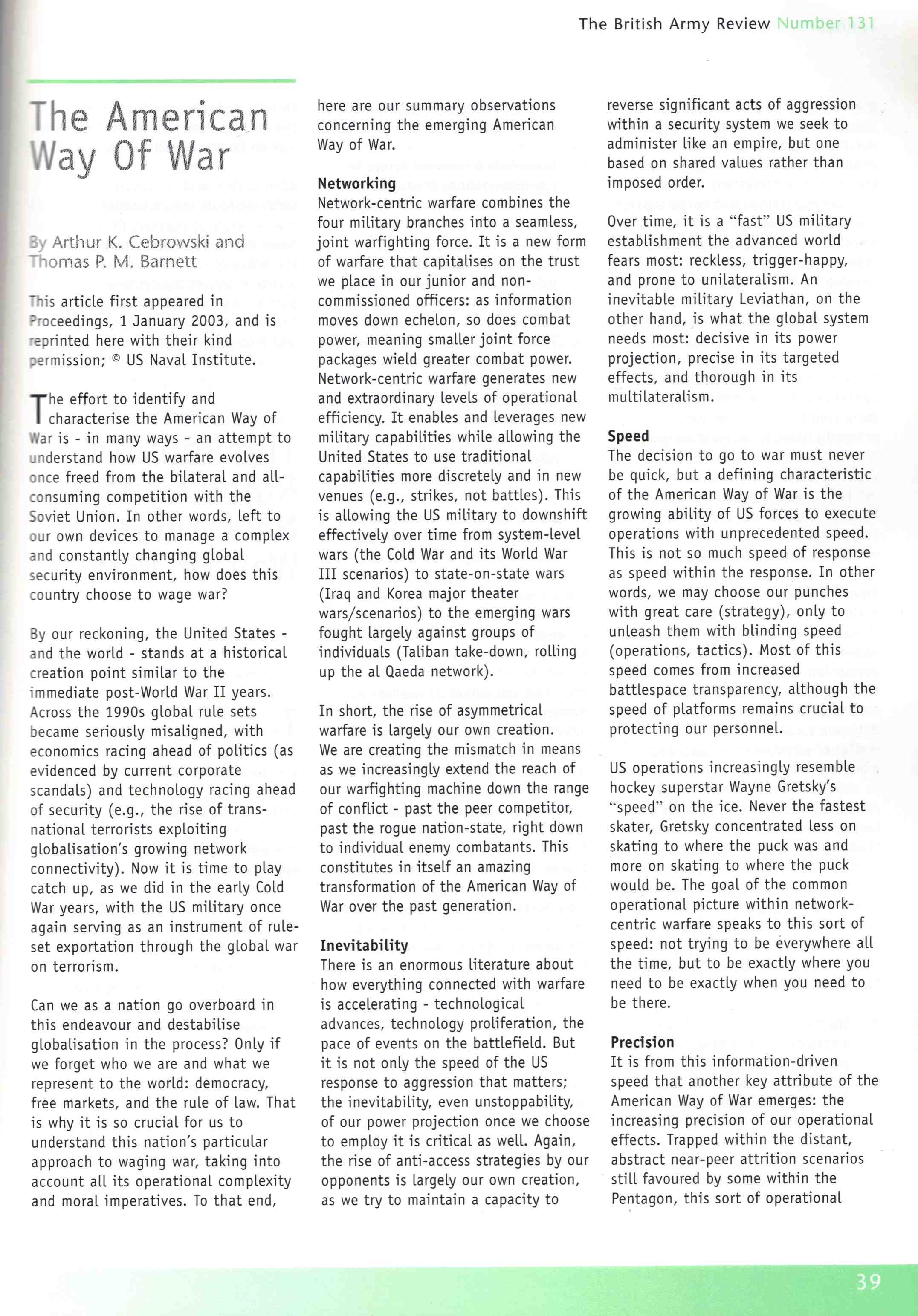
The American Way of War
by Arthur K. Cebrowski & Thomas P.M. Barnett
British Army Review, Spring 2003, pp.39-40;
reprinted with permission
U.S. Naval Institute Proceedings, January 2003, pp. 42-43;
reprinted with permission
The effort to identify and characterize the American Way of War is—in many ways—an attempt to understand how U.S. warfare evolves once freed from the bilateral and all-consuming competition with the Soviet Union. In other words, left to our own devices to manage a complex and constantly changing global security environment, how does this country choose to wage war?
By our reckoning, the United States—and the world—stands at a historical creation point similar to the immediate post-World War II years. Across the 1990s global rule sets became seriously misaligned, with economics racing ahead of politics (as evidenced by current corporate scandals) and technology racing ahead of security (e.g., the rise of transnational terrorists exploiting globalization’s growing network connectivity). Now it is time to play catch up, as we did in the early Cold War years, with the U.S. military once again serving as an instrument of rule-set exportation through the global war on terrorism.
Can we as a nation go overboard in this endeavor and destabilize globalization in the process? Only if we forget who we are and what we represent to the world: democracy, free markets, and the rule of law. That is why it is so crucial for us to understand this nation’s particular approach to waging war, taking into account all its operational complexity and moral imperatives. To that end, here are our summary observations concerning the emerging American Way of War.
The Networking of American Warfare
Network-centric warfare combines the four military branches into a seamless, joint warfighting force. It is a new form of warfare that capitalizes on the trust we place in our junior and noncommissioned officers: as information moves down echelon, so does combat power, meaning smaller joint force packages wield greater combat power. Network-centric warfare generates new and extraordinary levels of operational efficiency. It enables and leverages new military capabilities while allowing the United States to use traditional capabilities more discretely and in new venues (e.g., strikes, not battles). This is allowing the U.S. military to downshift effectively over time from system-level wars (the Cold War and its World War III scenarios) to state-on-state wars (Iraq and Korea major theater wars/scenarios) to the emerging wars fought largely against groups of individuals (Taliban take-down, rolling up the al Qaeda network).
In short, the rise of asymmetrical warfare is largely our own creation. We are creating the mismatch in means as we increasingly extend the reach of our warfighting machine down the range of conflict—past the peer competitor, past the rogue nation-state, right down to individual enemy combatants. This constitutes in itself an amazing transformation of the American Way of War over the past generation.
The Inevitability of American Warfare
There is an enormous literature about how everything connected with warfare is accelerating—technological advances, technology proliferation, the pace of events on the battlefield. But it is not only the speed of the U.S. response to aggression that matters; the inevitability, even unstoppability, of our power projection once we choose to employ it is critical as well. Again, the rise of antiaccess strategies by our opponents is largely our own creation, as we try to maintain a capacity to reverse significant acts of aggression within a security system we seek to administer like an empire, but one based on shared values rather than imposed order.
Over time, it is a “fast” U.S. military establishment the advanced world fears most: reckless, trigger-happy, and prone to unilateralism. An inevitable military Leviathan, on the other hand, is what the global system needs most: decisive in its power projection, precise in its targeted effects, and thorough in its multilateralism.
The Speed of American Warfare
The decision to go to war must never be quick, but a defining characteristic of the American Way of War is the growing ability of U.S. forces to execute operations with unprecedented speed. This is not so much speed of response as speed within the response. In other words, we may choose our punches with great care (strategy), only to unleash them with blinding speed (operations, tactics). Most of this speed comes from increased battlespace transparency, although the speed of platforms remains crucial to protecting our personnel.
U.S. operations increasingly resemble hockey superstar Wayne Gretsky’s “speed” on the ice. Never the fastest skater, Gretsky concentrated less on skating to where the puck was and more on skating to where the puck would be. The goal of the common operational picture within network-centric warfare speaks to this sort of speed: not trying to be everywhere all the time, but to be exactly where you need to be exactly when you need to be there.
The Precision of American Warfare
It is from this information-driven speed that another key attribute of the American Way of War emerges: the increasing precision of our operational effects. Trapped within the distant, abstract near-peer attrition scenarios still favored by some within the Pentagon, this sort of operational precision always risked seeming pointless. The objective of precision is not the weapons effect, but the enabling of our political objectives—effects-based operations. In the increasingly transparent battle space, the speed and access of our networked forces open the way to profoundly altering initial conditions of conflict, developing high rates of change that cannot be outpaced, and sharply narrowing an enemy’s strategic choices.
When downshifted by the global war on terrorism, such effects-based operational capabilities appear both more credible and more useful, primarily because in a war fought largely against individuals, the capacity for discrete applications of military power is prized most of all—likewise for focused, preemptive strikes against rogue states enabled by weapons of mass destruction.
The Transformation of American Warfare
Pulling together the major conceptual threads of the emerging international security environment, one is led to the conclusion that even when homeland security is the principle objective, the preferred U.S. military method is forward deterrence and strike operations. As a matter of effectiveness, cost, and moral preference, operations will have to shift from being reactive (i.e., retaliatory and punitive) to being largely preventative. Forward presence therefore will be valued more than strategic deployment from home, necessitating a major force posture shift from the current condition where 80%-plus of the force is U.S. based. Accordingly, the emerging American Way of War speaks to a future military force that features more:
- Special operations-like forces whose easier insertion and extensive local knowledge will give them greater power and utility than large formations deploying from remote locations
- Forces capable of applying information-age techniques and technologies to urban warfare, else we will not deny the enemy his sanctuary
- Surveillance-oriented forces to counter weapons of mass destruction, else unambiguous warning will come too late
- Concepts of “jointness” that extend down through the tactical level of war
- Interagency capabilities for nation building and constabulary operations, lest our elite forces get stuck in one place when needed in another
- Adjustments in force structure and posture in consideration of the growing homeland security roles of the Coast Guard, the National Guard, the Air National Guard, and the Reserves.
The ultimate attribute of the emerging American Way of War is the superempowerment of the war fighter—whether on the ground, in the air, or at sea. As network-centric warfare empowers individual servicemen and women, and as we increasingly face an international security environment where rogue individuals, be they leaders of “evil states” or “evil networks,” pose the toughest challenges, eventually the application of our military power will mirror the dominant threat to a significant degree. In other words, we morph into a military of superempowered individuals fighting wars against superempowered individuals. In this manner, the American Way of War moves the military toward an embrace of a more sharply focused global cop role: we increasingly specialize in neutralizing bad people who do bad things.
Adding these new responsibilities to the U.S. military is not only a natural development but a positive one, for it is the United States’ continued success in deterring global war and obsolescing state-on-state war that now allows us to begin tackling the far thornier issues of transnational threats and subnational conflicts—the battlegrounds on which this global war on terrorism will be won.
Admiral Cebrowski serves as Director, Office of Force Transformation, Office of the Secretary of Defense. Dr. Barnett, a Naval War College professor, serves as the Office of Force Transformation’s assistant for strategic futures. The authors are indebted to Henry Gaffney, Colonel Pat Garrett, U.S. Marine Corps, and Bradd Hayes for their input.
